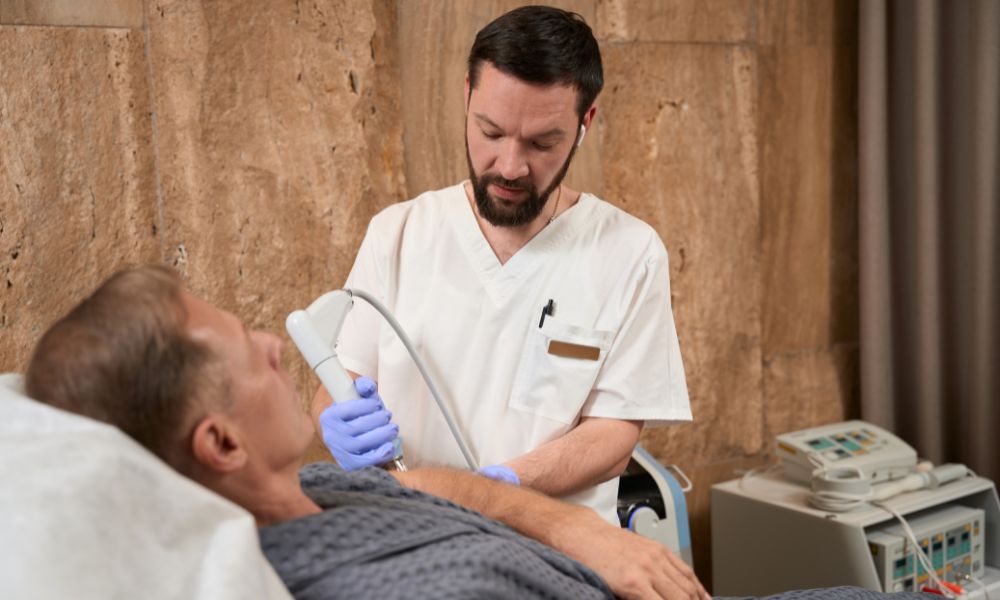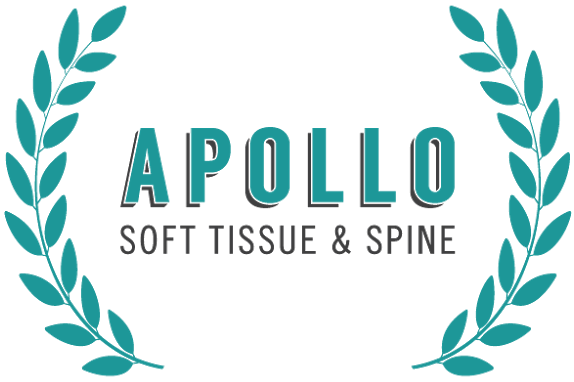For those considering shockwave therapy, knowing what to expect, especially in terms of comfort, can make the experience less intimidating. Many people are curious about whether shockwave therapy hurts and how it feels during each session. Understanding the pain levels and overall treatment experience is vital for anyone new to the process, as it helps in setting realistic expectations and preparing for a potentially beneficial journey in healing.
Shockwave therapy is a noninvasive treatment that supports pain relief and promotes healing in various soft tissue conditions, making it a valuable option for those seeking alternatives to more invasive approaches.
What is Shockwave Therapy?
Shockwave therapy, also known as extracorporeal shockwave therapy (ESWT), involves using high-energy sound waves to stimulate blood flow and cellular repair in injured tissues. This therapy is frequently used for conditions like plantar fasciitis, tennis elbow, Achilles tendinopathy, and jumper’s knee, among others.
The shockwave device emits focused or radial acoustic waves, directed at an injury site to help the body initiate a healing response. By enhancing blood circulation and promoting the release of growth factors, shockwave therapy works as a non-invasive solution to treat pain and inflammation in soft tissues, bones, and even certain types of sports injuries.

Is Shockwave Therapy Painful?
Pain perception during shockwave therapy can vary significantly from person to person, largely depending on individual pain tolerance and the specific area being treated. While some patients describe feeling sharp, dull, or tingling sensations, others report mild discomfort rather than outright pain.
Healthcare providers often take steps to minimize discomfort by adjusting the intensity of the waves or using numbing creams to desensitize the treatment area, especially for patients experiencing high sensitivity. The initial treatment session might be the most intense, with most patients noticing that any discomfort typically reduces as the therapy progresses and the body adapts.
Factors That Influence Pain Levels
Does shockwave therapy hurt? The level of discomfort experienced in shockwave therapy depends on several factors, including the severity of the condition being treated and the location on the body. For instance, areas with less muscle or softer tissue, like the heels and shoulders, may feel more sensitive to shockwave treatment.
Additionally, patients with lower pain tolerance may find the sensations more noticeable, while those with a higher pain threshold might experience little to no discomfort.
As the therapy works through compressed air or high-energy acoustic waves, these factors—combined with the patient’s unique response to pain—shape each individual’s experience during the sessions.
What to Expect During a Shockwave Therapy Session
A shockwave therapy session typically begins with a consultation, where a specialist assesses your condition, medical history, and the symptoms you’re experiencing. Once diagnosed, the therapist may provide a brief explanation of what to expect, answering questions about pain levels, potential side effects, and overall benefits.
In preparation for treatment, patients are usually asked to relax and stay as comfortable as possible while the therapist readies the equipment and marks the treatment area to ensure focused application.
The Treatment Procedure:
- Patients are comfortably positioned to allow easy access to the treatment area.
- The specialist applies a gel to the targeted area, helping the shockwaves penetrate the skin efficiently.
- A handheld device, which emits controlled high-energy sound waves, is then placed on the gel-covered skin.
- The therapist adjusts the device’s energy level based on the patient’s comfort and the specific needs of the condition.
- Treatment continues as the device moves in small, controlled motions, targeting specific injured tissues or areas of inflammation.
Throughout the session, patients might experience various sensations ranging from mild tingling to deeper, pulsating pressure. However, as the therapy progresses and the injured area begins to respond, most patients report that discomfort significantly decreases. Each shockwave therapy session typically lasts between 15 to 30 minutes, depending on the condition being treated.
Post-Treatment Expectations
After a shockwave therapy session, many patients report mild soreness or swelling in the treated area, similar to the sensation after an intense workout. This temporary discomfort is a natural response as the body begins the healing process, stimulated by the treatment. Some patients feel immediate relief, while others may notice gradual improvement over the following days.
Typical recovery time between sessions allows the body to process the effects of the therapy, with any soreness generally subsiding within a day or two. During this time, shockwave therapy works on a deeper level to support long-term healing by encouraging increased blood flow and tissue repair.
Over a few weeks of treatment, patients often experience substantial pain reduction, improved mobility, and enhanced strength in the affected area.
Comparing Shockwave Therapy Pain to Other Treatments
When considering pain relief options, many patients weigh shockwave therapy against other treatments. Understanding how shockwave therapy feels compared to alternatives like cortisone injections, surgery, or physical therapy can provide helpful insight.
Here’s a closer look at the relative comfort and effectiveness of each approach.
Shockwave Therapy vs. Cortisone Injections
Cortisone injections, commonly used for conditions like tendonitis and arthritis, offer rapid pain relief by reducing inflammation directly at the source. However, many patients find the injection itself to be fairly painful, with some experiencing soreness that lingers afterward.
While shockwave therapy may cause mild discomfort during treatment, many people find it less intense than the sharp sensation of a cortisone shot. Additionally, shockwave therapy supports long-term healing without the risks associated with repeated steroid use, making it a preferable choice for those who want to avoid frequent injections.
Shockwave Therapy vs. Surgery
For those facing surgery as a treatment option, shockwave therapy offers a less invasive approach with significantly lower pain and shorter recovery times. Surgical procedures often involve incisions, anesthesia, and a longer recovery process, along with the risks associated with any invasive operation.
In contrast, shockwave therapy is a non invasive treatment that doesn’t require downtime, allowing patients to resume regular activities relatively quickly. Many individuals choose shockwave therapy over surgery, especially when looking to avoid the discomfort and extended healing period that follow surgical interventions.
Shockwave Therapy vs. Physical Therapy
Physical therapy remains a widely recommended approach for managing pain and improving function, particularly for musculoskeletal conditions. However, some physical therapy exercises may cause discomfort during sessions, especially when targeting injured or inflamed tissues.
Shockwave therapy, on the other hand, can provide relief through short sessions that focus directly on the affected area. While both treatments may result in some soreness as the body adjusts, shockwave therapy is often reported to be less demanding on patients, delivering targeted relief with fewer sessions required.

Risks and Side Effects of Shockwave Therapy
Shockwave therapy is generally considered safe, with most patients experiencing only minor side effects like redness, bruising, or temporary soreness at the treated site. These effects are typically mild and resolve within a few days. In rare cases, patients may experience more noticeable discomfort or extended soreness, especially if the treatment area is particularly sensitive. Although uncommon, certain risks may include a slight risk of skin irritation or swelling that lasts longer than usual.
Who Should Avoid Shockwave Therapy?
While shockwave therapy offers promising results for many, certain individuals may need to avoid this treatment due to specific health conditions. Patients with clotting disorders or significant nerve damage, for example, might face increased risks during therapy, as the high-energy waves can interact negatively with these conditions.
Pregnant women are generally advised to avoid shockwave therapy as a precautionary measure, given the potential impact of the therapy’s focused energy on the body.
For those who cannot safely undergo shockwave therapy, alternatives like physical therapy, deep tissue massage, or conservative treatments, such as anti-inflammatory medications, may provide effective pain relief and healing without the risks associated with shockwave sessions. Consulting a healthcare provider can help individuals choose the best approach tailored to their
Is Shockwave Therapy Worth the Discomfort?
For most patients, the temporary discomfort experienced during shockwave therapy is outweighed by the long-term benefits it provides. While some may feel mild to moderate pain during treatment, this discomfort is often brief, diminishing as the body adjusts to the therapy. Many find that the results—reduced pain, improved mobility, and faster healing—justify the sensations felt in each session.
Over time, shockwave therapy encourages tissue regeneration and increased blood flow, promoting sustainable pain relief that outlasts the temporary discomfort. For individuals seeking a noninvasive, effective solution to persistent pain, shockwave therapy is often a worthwhile choice.
Is Shockwave Therapy Right for You?
If you’re considering shockwave therapy, understanding the sensations and what to expect can make the experience smoother and less intimidating. While it may cause temporary discomfort, the benefits for long-term healing and pain relief often make it a worthwhile option, especially compared to invasive treatments.
Talking with a specialist about your specific condition and comfort level can help you decide if this therapy aligns with your goals. With a bit of preparation and knowledge, shockwave therapy might just be the step you need toward effective, lasting pain relief.



